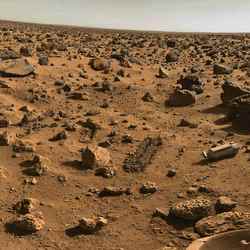
Mars seems not to be as wet as it was predicted. Image credit: NASA Click to enlarge
A region of Mars that some planetary scientists believe was once a shallow lakebed and likely habitable for life may not have been so wet after all, according to a new University of Colorado at Boulder study.
The new study indicates chemical signatures in the bedrock, interpreted in 2004 by the Mars Exploration Rover, or MER, mission team as evidence for widespread, intermittent water at Mars’ surface, may have instead been created by the reaction of sulfur-bearing steam vapors moving up through volcanic ash deposits. Known as Meridiani Planum, the region may have been more geologically similar to volcanic regions in parts of North America, Hawaii or Europe, said Thomas McCollom of CU-Boulder’s Center for Astrobiology.
“Our study indicates it was probably more like parts of Yellowstone, Hawaii or Italy than something like the Great Salt Lake,” said McCollom, also a research associate at CU-Boulder’s Laboratory for Atmospheric and Space Physics. “We think it was far less favorable for past biological activity than other scenarios that have been proposed.”
A paper on the subject by McCollom and CU-Boulder Research Associate Brian Hynek of CU-Boulder’s LASP appears in the Dec. 22 issue of Nature.
A series of scientific papers published in December 2004 by the Mars Exploration Rover team and based on data gathered by the rover Opportunity, concluded that the Meridiani Planum region once probably had a large sea or huge lake that may have waxed and waned over eons. The authors proposed that the evaporation of surface and subsurface water over time left behind various chemical precipitates — predominately sulfate salts — which they interpreted as evidence for a watery environment that would have been conducive for life to exist.
But if the sulfate was the result of precipitation from an evaporating brine of surface and subsurface water as has been proposed, McCollom and Hynek contend the bedrock should be enriched with a large amount of positively charged atoms, known as cations, from minerals like iron, calcium and magnesium. But it is not, they said.
“We think the bedrock was laid down by enormous volcanic ash flows over time that were then permeated by sulfur dioxide-rich steam vapors,” said McCollom. “The sulfur dioxide and water combined to form sulfuric acid, which reacted with and altered the bedrock to give it its present chemical composition.”
The new scenario does not require prolonged interaction between bedrock and a standing body of surface water as proposed by the MER team, and the process likely occurred at high temperatures, perhaps more than 200 degrees F, said McCollom. “Everything about the site seems to be consistent with our conclusions,” he said.
“In our scenario, the water required to support the chemistry in this bedrock would only have had to have been around for months, years or perhaps as much as a few centuries,” said Hynek. “This is very different than previous scenarios, which require that a much larger amount of water be present for many millennia.”‘
The European Space Agency’s Mars Express spacecraft recently showed the chemistry of layered deposits surrounding the Meridiani Planum region is similar to the bedrock at the Opportunity landing site, implying the entire area hosted volcanic activity, said Hynek. The size of the suspected Meridiani Planum volcanic deposits appears much larger than any similar deposit on Earth and encompasses an area roughly the size of Arizona, according to the CU-Boulder researchers.
McCollom described the geology of the region as “solfatara-like,”‘ a term that originated from Solfatara Crater, a volcanic region near Naples, Italy, harboring vents that emit vapors. “While solfataras are riddled with vents and fissures giving off sulfurous vapors at the surface, the deposits we see at Meridiani probably represent the subsurface beneath such fissures,” said McCollom.
On Earth, solfataras host microbes that are capable of using sulfur for sustenance, McCollom said. Some of the areas are now under study by astrobiologists looking to characterize extreme environments on Earth that support life.
“My view is that there is a good possibility there is life on Mars, probably in the subsurface,” he said. “We know from examples on Earth that life can exist in extreme places, and Mars seems to have the necessary ingredients for that.”
Hynek said that in the distant past, Meridiani Planum may have had all the necessary ingredients to support organisms like those found in solfataras. “But the unique and probably short-lived nature of the environment suggests it may not be the best place to look for evidence of Martian life today,” he said.
Original Source: CU-Boulder News Release
